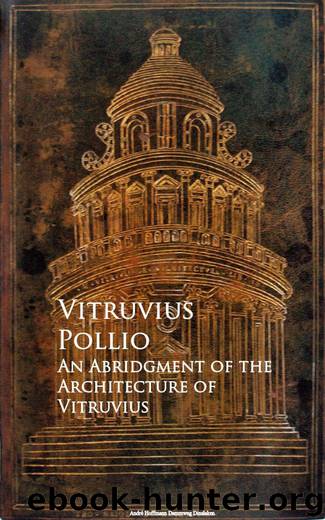An Abridgment of the Architecture of Vitruvius by Vitruvius Pollio

Author:Vitruvius Pollio [Vitruvius Pollio]
Language: eng
Format: epub
Published: 0101-01-01T00:00:00+00:00
ART. VI.
Of the Dorick Order.
HE Dorick Pillar has had in divers times, and in different Buildings, different Proportions; for at first it had only for its height 6 times its Diameter; this Proportion imitating that of Humane Bodies, in Lib. 4.
Chap. 1. which the length of the Foot is the 6th part of all the Body, afterwards they allowed 7 times its Diameter.
But this Proportion that the Pillars of the Temples had at the Beginning, was afterwards changed in that of the Theaters, where they were higher by half a Diameter; for they made them 15 Modules high, for in the Dorick Lib. 5.
Chap. 9. Order the Semi-Diameter of the Pillar at the bottom is the Module, which in other Orders is a whole Diameter.
The Dorick Pillar is composed as well as the rest of a Shaft, Base and Capital, though Vitruvius makes no mention of the Base ; and it’s easie to conclude, that in the Ancient Buildings this Order had none; for it is said, That when they would make the Ionick Order more Beautiful than the Dorick, they added a Base to it; Lib. 4.
Chap. 1. and there is yet to be seen in Ancient Buildings of this Order, Pillars without a Base ; but when a Base is added to it, it must be Attick Base, whose Proportion is as follows.
The whole Base ought to have a Module for its height; that is to say, half the Diameter of the Pillar; this Module being divided into three parts; one is for the Plinthus ; the other two parts are divided into four, of which one is allowed for the upper Torus, the three which remain, are divided into two: The half below is for the lower Torus, the other is for the Scotiæ, comprising the two little Squares or Filets. The breadth of the Basis in General is a 4th of the Diameter of the Pillar at the bottom, added on every side; but this jetting is excessive, and without any Example, and Vitruvius himself makes it lesser in the Ionick Base.
The height of the Capital as well as the Base is one Module, the breadth is two Modules and an half, the height of the Capital being divided into three parts, one must be allowed for the Plinthus or Abacus, with its Cymatium ; Lib. 4.
Chap. 3. the other is for the Echine, with its Anulets ; the third appertains to the Gorge of the Capital.
The Architrave which comprehends its Platte-Band with the Gouttes or Pendant Drops, which are under the Triglyphs, is as well as the Capital of one only Module ; the Gouttes or Drops with their little Tringle, ought to have the 6th part of a Module, the breadth under the Architrave ought to be equal to that above the Pillar.
Upon the Architrave in the Friese ought to be the Triglyphs and the Metops. The Triglyphs have a Module and a half for their height, and a Module for their breadth; the
Download
This site does not store any files on its server. We only index and link to content provided by other sites. Please contact the content providers to delete copyright contents if any and email us, we'll remove relevant links or contents immediately.
Kathy Andrews Collection by Kathy Andrews(11730)
The remains of the day by Kazuo Ishiguro(8821)
Paper Towns by Green John(5089)
Spare by Prince Harry The Duke of Sussex(5072)
Industrial Automation from Scratch: A hands-on guide to using sensors, actuators, PLCs, HMIs, and SCADA to automate industrial processes by Olushola Akande(4978)
The Body: A Guide for Occupants by Bill Bryson(4974)
Machine Learning at Scale with H2O by Gregory Keys | David Whiting(4178)
Be in a Treehouse by Pete Nelson(3946)
Never by Ken Follett(3790)
Harry Potter and the Goblet Of Fire by J.K. Rowling(3773)
Goodbye Paradise(3727)
Into Thin Air by Jon Krakauer(3312)
The Remains of the Day by Kazuo Ishiguro(3293)
The Cellar by Natasha Preston(3260)
The Genius of Japanese Carpentry by Azby Brown(3224)
Fairy Tale by Stephen King(3220)
120 Days of Sodom by Marquis de Sade(3179)
The Man Who Died Twice by Richard Osman(2997)
Drawing Shortcuts: Developing Quick Drawing Skills Using Today's Technology by Leggitt Jim(2996)
